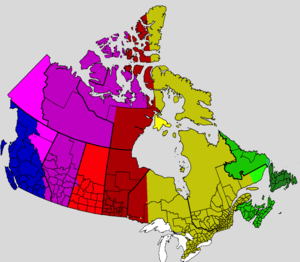Time zones in Canada

| Standard time | Summertime | English name | |
|---|---|---|---|
| UTC − 03: 30 | UTC − 02: 30 | Newfoundland Time | |
| UTC − 04: 00 | UTC − 03: 00 | Atlantic Time | |
| UTC − 04: 00 | Atlantic Time | ||
| UTC − 05: 00 | UTC − 04: 00 | Eastern time | |
| UTC − 05: 00 | Eastern time | ||
| UTC − 06: 00 | UTC − 05: 00 | Central time | |
| UTC − 06: 00 | Central time | ||
| UTC − 07: 00 | UTC − 06: 00 | Mountain time | |
| UTC − 07: 00 | Mountain time | ||
| UTC − 08: 00 | UTC − 07: 00 | Pacific time | |
Canada is divided into six time zones and is only surpassed by Russia , the United States and, if you add their overseas territories or outer islands, Australia and the United Kingdom . Most of the country uses daylight saving time , but there are exceptions.
Zones
Pacific Standard Time (UTC − 8)
Pacific Standard Time ( UTC − 8 , corresponding daylight saving time UTC − 7 ) is used in the following regions:
- British Columbia (most of the province)
- Yukon ( Yukon Standard Time has been abolished)
Mountain Standard Time (UTC − 7)
Mountain Standard Time ( UTC − 7 , corresponding daylight saving time UTC − 6 ) is used in the following regions:
- Alberta
- British Columbia (all of East Kootenay and Peace River regional districts and parts of Columbia-Shuswap regional district )
- Northwest Territories
- Nunavut (west of 102 ° west)
- The Lloydminster parish in Saskatchewan , which adopts Alberta's zone time.
Central Standard Time (UTC − 6)
Central Standard Time ( UTC − 6 , corresponding daylight saving time UTC − 5 ) is used in the following regions:
- Manitoba ,
- Nunavut (between 85 ° West and 102 ° West)
- Ontario (west of 90 ° west)
- Saskatchewan
Eastern Standard Time (UTC − 5)
Eastern Standard Time ( UTC − 5 , corresponding daylight saving time UTC − 4 ) is used in the following regions:
- Nunavut (east of 85 ° west, but Southampton Island entirely)
- Ontario (most of the province)
- Québec (most of the province)
Atlantic Standard Time (UTC − 4)
Atlantic Standard Time ( UTC − 4 , corresponding daylight saving time UTC − 3 ) is used in the following regions:
- Labrador (except the extreme southeast which takes over the respective time from Newfoundland),
- New Brunswick ,
- Nova Scotia ,
- Prince Edward Island ,
- Québec (east of 63 ° or the Nateshquan River)
Newfoundland Standard Time (UTC − 3: 30)
Newfoundland Standard Time ( UTC − 3: 30 , corresponding daylight saving time UTC − 2: 30 ) is the only time zone in Canada with no full hourly difference from UTC and in use on the island of Newfoundland .
Summertime
Daylight saving time is common in Canada in all provinces and territories except Saskatchewan . Although time sovereignty in Canada lies with the provinces, the practice of synchronizing the beginning and end of daylight saving time with the USA has developed since the 1960s . A change to the 2005 regulation, in which the start of summer time was brought forward, was also adopted by the individual provinces. Some communities that are on the border of time zones do not adopt daylight saving time; in most cases this has no official status.
Web links
- Canadian time zone maps on National Research Council of Canada
- It's about TIME on Canadian Geographic
- Official Times across Canada